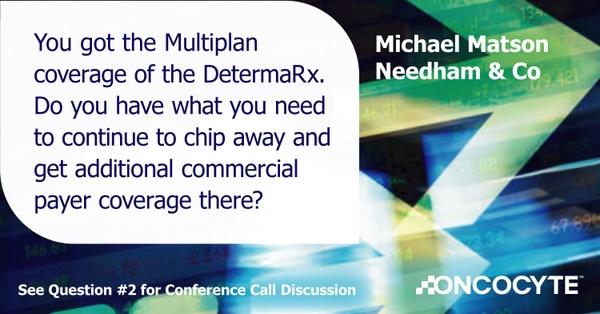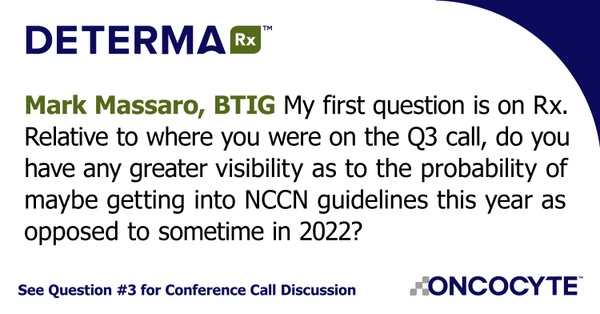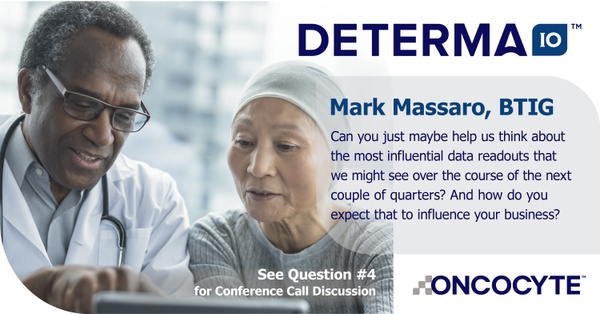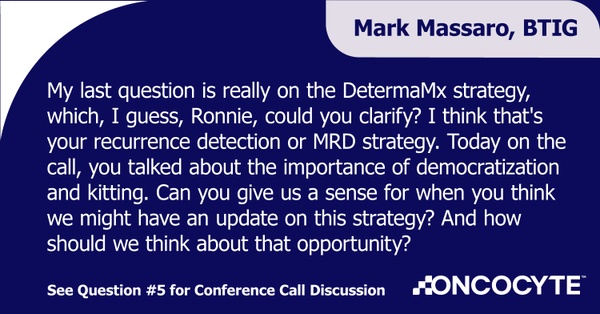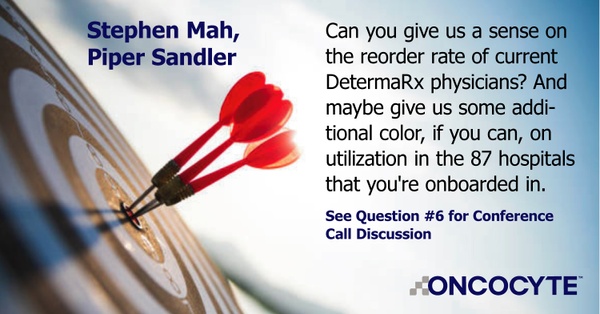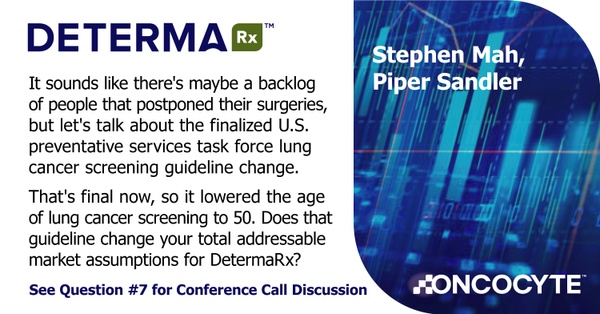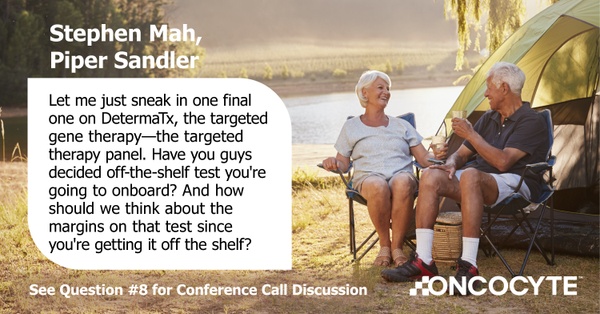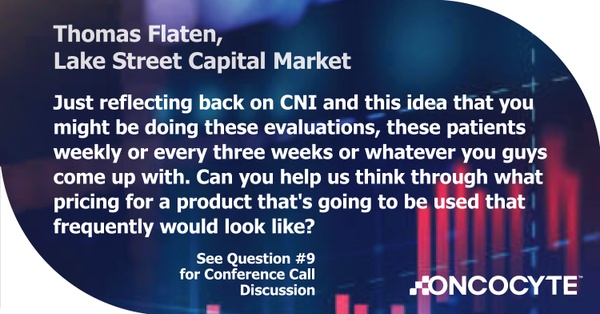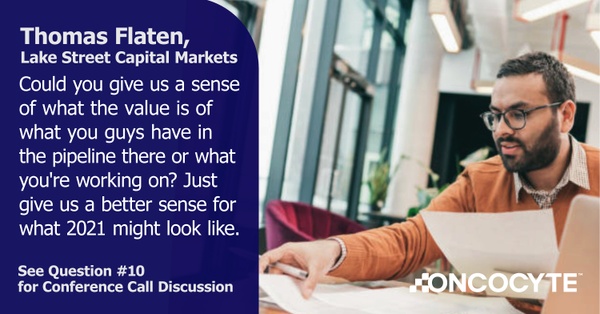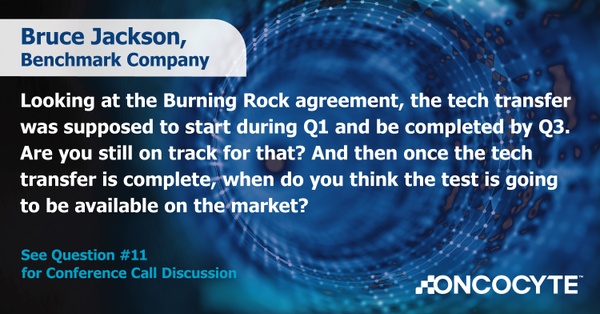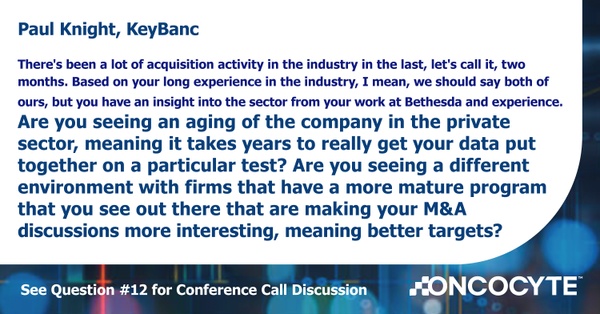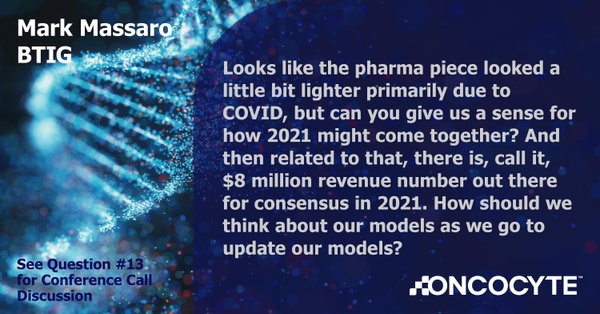Ronald Andrews, CEO, Oncocyte
Over the past year, we've made great strides in advancing our mission to create a one-stop lab of comprehensive molecular diagnostic offerings that answer critical unanswered questions for physicians and patients for the management of solid tumors. We transformed from the Oncocyte of 18 months ago - a single asset development stage company, to a commercial stage revenue-generating business, advancing tests that optimize cancer treatment decisions to improve patient outcomes and reduce the overall cost of care.
We accomplished a great deal in the last year, strategically identifying and acquiring a portfolio of compelling tests, integrating these assets, completing clinical development, and ultimately launching two proprietary tests for critical decisions that previously lacked precision diagnostics. Through these efforts, we've emerged as leaders in early-stage lung cancer management, efficiently growing revenues with a concentrated sales effort in key markets, bolstered by virtual programs that reach health care providers across the U.S. despite the global pandemic.
There's more to come in 2021, with important content for treatment response and for recurrence monitoring. So together, this means we're well on our way to becoming a one-stop shop, or in our world, a one-stop lab for oncologists and surgeons treating lung cancer patients.
There are four current products and services that make up the company growth engines:
- DetermaRx™, the first and only commercially available predictive test for informing chemotherapy decisions in early-stage lung cancer is now reimbursed by Medicare, and experiencing solid quarter-over-quarter volume and revenue growth.
- DetermaIO™, our proprietary test for predicting response and identifying incremental responders to first generation immune checkpoint inhibitor drugs, also known as ICIs. DetermaIO is currently available for use in clinical research and pharma trials, and is on track for our clinical launch in Q4 of 2021.
- TheraSure™ CNI Monitor test for immunotherapy response monitoring, with plans to soon rebrand as DetermaCNI. This recent product addition represents our first move into the massive opportunity that is emerging to monitor cancer patients for treatment efficacy in real time.
- Pharma Services from the company’s CAP-accredited CLIA lab in Nashville, providing a comprehensive menu of test development and validation services for pharma and for diagnostic companies
Why being a one- stop shop is so important
Physicians treating patients diagnosed with cancer need rapid biomarker testing to inform treatment selection, such as targeted therapy, immunotherapy and chemotherapy. By combining a differentiated test like the DetermaIO to inform the use of immunotherapy with standard of care genomic tests for things like EGFR ALK ROS-1, oncologists will have best-in-class testing that delivers comprehensive information to make a treatment decision.
DetermaRx, DetermaIO and DetermaCNI are all proprietary tests that will only be offered by Oncocyte. This puts the company in a very strong position to become the preferred lab for clinicians who need answers to the important treatment decisions that only Oncocyte can answer. Once a hospital is on-boarded as an Oncocyte customer, this creates a same-store sell opportunity and the opportunity to offer more traditional tests like the upcoming targeted therapy panel brand, DetermaDx.
This one-stop shop strategy offers practical advantages. One, currently, the testing needs of physicians managing cancer are usually only able to be met by several specialty labs. What this means is the provider must split the sample and send it to several different labs. Not only does this consume a large amount of sparse patient biopsy sample, but it can take up to three weeks to deliver critical results that doctors need to drive important treatment decisions.
Consolidating all the required tests facilitates more judicious use of precious patient biopsy samples and also expedites delivery of results to the ordering position within only 10 days, a time frame that the customer base continues to highlight as a target for optimizing therapy decisions.
DetermaRx, is the first and only predictive tests for the identification of patients with stage 1 to 2 non-squamous cancer who are high-risk for recurrence following surgery.
It's been a big year for DetermaRx, with the launch of the test in February, 2020 as an early access program with six reps. Also announced was the final Medicare coverage determination which secured national Medicare payment for DetermaRx effective August 2020. This is significant as Medicare patients account for approximately 70% of eligible patients nationwide. On top of that, DetermaRx received centers for Medicare and Medicaid Services, or CMS, high-value pricing.
Also, an agreement with Multiplan network to expand patient access to DetermaRx to approximately 60 million more covered lives at a negotiated price in line with the CMS pricing. Many of these patients have insurance with companies like United Healthcare. Multiplan's role, much like lab benefit managers in pharma, is to negotiate a payment for diagnostic and other services with companies like Oncocyte. This represents the company’s first major payer contract outside of Medicare.
Recent Stats
- Over 3,000 health professionals reached
- 87 hospitals on-boarded
- Broad adoption at prestigious national comprehensive cancer centers as well as National Cancer Institute hospital sites
Test revenue and volume quarter-over-quarter continues to grow despite a well-established seasonal pattern of fewer oncology surgeries in the fourth quarter each year. Moreover, this seasonality this year was exaggerated by the pandemic as certain oncologists chose to defer inpatient lung cancer surgeries that are needed to trigger the use of DetermaRx.
Despite all those headwinds, the commercial team delivered an impressive 36% quarter-over-quarter sample volume and a 58% quarter-over-quarter revenue growth, which reflects the carryover from claims in Q3. In addition, the sales team has expanded to a total of 10, which now provides coverage of over 75% of the surgeons performing early-stage lung cancer surgeries. When you add that to improving the macro environment and combine it with continued Q4 momentum, the company has confidence in its ability to achieve 2021 annual goals for samples and revenue for DetermaRx.
Also in December, a strategic agreement with Burning Rock to distribute DetermaRx in China was announced. The agreement with Burning Rock Biotech, a $3.5 billion market cap NASDAQ-listed company, aligns Oncocyte with one of China's fastest-growing molecular labs focused on cancer therapy selection, and provides entry into the world's largest early-stage lung cancer market that is approximately six times the size of the U.S. market, doing over 250,000 surgical resections for lung cancer each year.
DetermaIO: proprietary gene expression profile test should propel Oncocyte to a leadership position in the approximately $3 billion immune therapy decision market.
This test is the only precision diagnostic test on the market today that evaluates the entire immune micro-environment in biopsies or surgical specimens from cancer patients in order to identify patients likely to respond to immune checkpoint inhibitors. The test delivers a comprehensive picture of the immune micro- environment by combining the so-called hot signal derived from inflammatory cells in the tumor and cold signal coming from the wound response along with the use of a proprietary algorithm that scores each patient's result.
In addition to the DetermaIO being an excellent predictor of response to checkpoint inhibitors, the cold signal may identify key biologic signals targeted by second-generation target therapeutics that are now in clinical trials. As a result, DetermaIO may be an ideal biomarker to inform therapeutic strategies that combine checkpoint inhibitors with these emerging next-generation therapies.
Key Stats for DetermaIO
- More than 750,000 patients eligible annually for immunotherapy in the U.S. alone
- Depending on reimbursement levels, that translates to a $2.5 billion to $3 billion market opportunity.
- Worldwide, there are currently nearly 5,000 ongoing clinical trials evaluating these drugs. That represents another large opportunity to help pharma companies identify patients for their trials.
- This market is expected to continue to grow substantially as the reach of immunotherapy expands to new indications in earlier stages of cancer.
The company has successfully completed the first announced immunotherapy biomarker collaboration for the immune therapy, atezo, as it's commonly called, and we will be presenting these results in an upcoming scientific meeting. This collaboration was with Fondazione Michelangelo, a leading non-profit cancer research organization headquartered in Milan, Italy. This work is for an investigator-sponsored trial that evaluated DetermaIO as a biomarker of neoadjuvant checkpoint inhibitor response in triple-negative breast cancer. This is a very meaningful accomplishment, given PD-L1 IC failed to sufficiently identify responders in this setting.
If DetermaIO is successful as a predictive biomarker for this drug, it would expand atezo's indications from late-stage treatment to neoadjuvant therapy, which will be a significant milestone for patients with this horrible disease as well as for DetermaIO's commercial development.
Over the coming months, the company will present data at major scientific meetings via peer-reviewed publications that will demonstrate the potential of DetermaIO across a very broad range of tumor types, starting with well-established clinical data across three different cancers: lung, breast and now the recently announced bladder cancer data. DetermaIO will allow Oncocyte to address a fundamental challenge in immunotherapy, which is identifying the right patients for treatment.
But that's only part of the immunotherapy story, and that's where TheraSure CNI Monitor clinical assay comes in. With the recently announced intent to acquire Chronix Biomedical, which is on track to close within the next 30 days, we will now have proprietary access to the TheraSure CNI Monitor test, a patented blood-based assay that uses copy number instability or, CNI, for immune therapy response monitoring.
Now, OncoCyte is well-positioned to enter the rapidly growing blood-based therapy response monitoring market. The plan is to rebrand the test to DetermaCNI and launch as a pharma service in Q2 from a new molecular Center of Excellence in Germany for the European market. After tech transfer to the company's U.S. facilities, they plan to launch the test for pharma's use in domestic immune-therapy clinical trials in Q4 of 2021.
CNI differs from other tests in that it is blood-only or tumor-naive, meaning it does not require tumor tissue or extensive genomic scale sequencing prior to blood monitoring to accurately interpret tumor resistance and progression during treatment. By focusing on a test that can deliver results independent of tumor tissue genotype, it delivers progression data before the tissue and form technologies even have their custom assay ready for the first baseline test. As well, it can perform monitoring of cases where tissue is inadequate for testing.
Tissue is extremely sparse in lung cancer, where a majority of the biopsies are finding all aspirates rendering very little tissue for analysis. A new test will deliver important progression data with no tissue use by the second therapy treatment cycle or within six weeks, long before imaging of competing tissue inform technologies deliver their results.
As a reminder, response monitoring will play an important role in patient management going forward, allowing physicians to identify a tumor that is becoming resistant to treatment early in the treatment cycle. That insight can drive a change in treatment to second-generation therapy or in combination with chemotherapy before disease progression, improving the odds of long-term survival and reducing the overall cost of care.
From a strategic perspective, the TheraSure CNI Assay Monitor not only helps expansion into the projected $3 billion and growing immunotherapy response monitoring market, it also allows U.S. ownership of IP that could help establish a foundation to build additional applications for the over $6 billion recurrence monitoring market, a repeat testing opportunity to tell a patient that a new tumor may be forming long before it can be identified in imaging.
These additions further solidify the company position as a one-stop lab for both immunotherapy response prediction and now for monitoring. By offering both DetermaIO and therapy monitoring test, OncoCyte will be the first and only company to provide a comprehensive solution that addresses two of the biggest outstanding challenges in the field: knowing which patients to treat with immunotherapy as standalone or in combination, as well as informing whether a treatment is effective through cost-effective monitoring.
Oncocyte is excited about the Chronix acquisition and looks forward to integrating their world-class team of experts in blood-based monitoring test as well as gaining a lab in Germany to use as a beachhead for commercial entry into the EU with a full menu of products.
Finally, touching upon our boutique pharma services business, Oncocyte has made great progress on this growing source of revenue for Oncocyte, with contracts now executed for 16 clients across both pharma and diagnostic industry heavy-hitters, including some companies like Boehringer Ingelheim, Eastside Pharmaceuticals, Promega, QIAGEN, PlexBio and Ono Pharmaceuticals, as well as others. The company successfully engaged with these clients to provide services such as sequencing for pharmaceutical development through the validation and verification for clinical use. They see this as just the beginning of a successful business model that aims to form true partnerships to support pharma drug development with discovery stage projects and clinical trial support, all the way through regulatory and commercialization support of companion diagnostics in partnership with molecular diagnostics companies.
In Q4, the company was audited by a top 20 pharma company and a top three genetic sequencing company and passed with flying colors, and are now engaging in and developing statements of work with both to become a lab of choice for key development projects, which they expect will strengthen a rich pipeline of work ahead.
Another important advantage, the Q1 initiation of a project that was scheduled to begin in Q4 for a top 20 pharma company, utilizing a proprietary blood-based cell cycle test for monitoring assistance in the pharma partner's Phase III trial. This is the first major trial using this new test application, which was developed in-house in Nashville specifically for this indication.
The pharma services lab is incredibly efficient. With current committed projects, the company is set to deliver gross margins that can drive positive cash contributions to P&L over the course of 2021. Just like DetermaRx, the pharma services business provides an immediate and growing revenue engine, which will support operations as well as strategic development of future tests for the sales channel.
2020 was clearly a milestone year for Oncocyte. We believe we've laid an incredibly strong foundation with a diversified portfolio of derisked growth engines for immediate, near-term and for long- term growth while establishing leadership in early-stage lung cancer.

Question 1
Michael Matson Needham & Co: I'll start with DetermaRx. Can you talk about your plans to expand the sales force in 2021? I don't know if you're willing to give us any targets on that.
Ronald Andrews: High level, we have 10 that we have plans to hire. As we bring out the DetermaIO and DetermaTx and potentially CNI, we will actually, at that point in time, evaluate our need to add further representation just given the importance of detailing not only thoracic surgeons, but now a larger cadre of medical oncologists. The plan is to hold tight until probably third quarter and then evaluate where we are in terms of the need to add more reps for the launch of IO.
Question 2
Michael Matson: You got the Multiplan coverage of the DetermaRx. Do you have what you need to continue to chip away and get additional commercial payer coverage there?
Padma Sundar, Chief Commercial Officer, Oncocyte:
Yes. We're doing it two ways. One is we are fighting for payment for every claim with a very aggressive appeal strategy. Then in addition to multi-plan, we have several conversations going with other networks where our value proposition and publication-based evidence is strong. We are going to continue to chip away, and we hope to get additional contracts this year. Of course, once they're in NCCN guidelines, that's when we believe we'll get 90% of the payers to pay for the test and we'll be in good shape at that point.
But even between now and then, we do have several additional payers that we're engaged in discussions with in addition to Multiplan, and this announcement should be coming out during the course of the year.
Question 3
Mark Massaro, BTIG: My first question is on Rx. Relative to where you were on the Q3 call, do you have any greater visibility as to the probability of maybe getting into NCCN guidelines this year as opposed to sometime in 2022?
Padma Sundar: Yes. Our goal is to submit the application certainly this year. One of the things is, although the NSCLC or lung cancer guidelines are updated quite frequently, the updates that they do with respect to biomarkers typically happen only once a year. Even though we are ready to submit the application this year for the summer meeting in July, the public information on the decision will perhaps not be known until the end of the year in November. That's the strategy. We submit the application this year. We should find out publicly by the end of this year, and so if it's favorable, it should start impacting our—we'll make it public later this year, and it should start impacting our volumes the following year in 2022. That's the strategy.
I will say that because the Rx test is so widely available, a lot of the committee members have become aware of the test and the data associated with it, and we've gotten some positive feedback that they like. They understand unmet medical needs. They know there's nothing else out there that serves their medical needs. They have been quite positive in their reaction to the data that they've seen so far.
Doug Ross, M.D., Ph.D., Chief Scientific Officer, Oncocyte: I'm cautious and don't want to speak for the committee for reasons that it's an independent committee, and so we don't want to project and they formally can't give us feedback until they give us feedback. But the conversations that we are continuing and we are aggressive about, making sure that everybody knows about it and understands it, and those conversations have been very receptive and positive. It's not really new news, but it's an ongoing process that we're enthusiastic and optimistic about.
Ronald Andrews
Mark, let me refresh, for everyone's edification, the important fact that we reclassified 48% of the NCCN negatives in our prospective trial. What that meant is that their standard of care today called 48% of those patients low risk, which we flipped to high risk, meaning that about 50% of those patients are only going to have a five year survival rate of 49%. The rest without treatment are not going to make it. The reality is that we offer, I think, a substantial opportunity to improve the current standard of care, and that has been what we've received very positive feedback on.
Question 4
Mark Massaro
Great. Then on DetermaIO, I know you've referenced the study in Italy. It appears that you have some data at AACR, but can you just kind of—and then of course, ASCO is coming up. Can you just maybe help us think about the most influential data readouts that we might see over the course of the next couple of quarters? And how do you expect that to influence your business?
Douglas Ross, M.D. We recently released the press release on the bladder cancer data that we're going to be showing at AACR. There's actually two things being shown there. One is sort of the coming out, if you will, of our approach to looking in a pan-cancer way. We believe that this test is applicable across all different solid tumor types. We've established that through looking at different tumor types and the classification function. We did get a symposium podium presentation for the bladder cancer data, and this is the retrospective analysis of an atezo clinical study in bladder cancer. We're excited that that data is going to become public, and then there's obviously a lot more than what's in our press release or the abstract. We're excited for that.
As we progress to ASCO, we haven't obviously guided much on what's going to come down the line, but I would say that this year is about exposing data in more and different tumor types. That's what I would expect across the year. We have talked publicly about the Italian data, the NEO trip data. Once again, this is a Roche/Genentech clinical study that's ongoing.
We've completed analysis of the clinical part of that study and are excited to be presenting that, likely at ESMO later in the year, but that's to be determined. Of course, all of this data is being put into peer-reviewed publications, including the data that we've shown at previous meetings. We'd like to have all of that published by the end of the year. But of course, for instance, the Italian study is in the hands of our academic collaborators who are great partners in this and that were also subject to the wins of the journal. That's the plan.
Ronald Andrews Please let me just add this. As you know already, but for everyone's edification, we have to be guarded in how much data we give out. These data sets are not ours. They're our investigators, they're embargoed at times because they're waiting to be published. The last thing we want to do is get ahead of them, because then we run the risk of not having it published because it's already used in the public. I do think we've got a rich opportunity this year to deliver some pretty exciting data, and we look forward to each one of these meetings so that we can get more and more data out there, proving the utility across pan-cancer.
Padma Sundar I just want add. As well as peer-reviewed publications that will be available this year, which is kind of the icing on the cake.
Question 5
Mark Massaro: My last question is really on the DetermaMx strategy, which, I guess, Ronnie, could you clarify? I think that's your recurrence detection or MRD strategy. Today on the call, you talked about the importance of democratization and kitting. Can you give us a sense for when you think we might have an update on this strategy? And how should we think about that opportunity?
Ronald Andrews: Yes. As I said, Mark, just to reiterate and be clear, we have DetermaCNI, which is a product that's already developed, and just needs to go through its paces of clinical validation, much like where we were a year ago with DetermaIO. This year, it's all about running that same playbook and getting DetermaCNI into trials and started getting it closer to reimbursement and market.
DetermaMx is a development project. I have to be careful, we have opportunities with certain partners that we have worked with through our years that have IP around ways to make PCR more sensitive and to allow us to use surrogate markers in blood that would identify a recurring tumor. So while it's a little different than MRD just looking for minimal residual disease, this opportunity, we believe, will look for sets of markers that will identify activity that won't probably more than likely require a reflex test to a much larger blood-based genetic panel to actually identify what's going on and what treatment to use.
This is right out of the playbook from monitoring across every other disease, most recently, obviously, across infectious disease, much like HIV. Where we monitor HIV viral load, the viral load changes, we reflex to a genotype. The genotype is what we press against the database, the treatment protocols, to know what patients are going to respond or what this patient will now respond to, based on the failure of the current regimen.
Our approach is very similar to that approach. We suspect that by this time next year, we'll have data. We'll be able to talk a lot more about the data, and hopefully, we'll be in the same position next year with papers being published or preparing to publish papers and abstracts so that we can speak more clearly to it.
At this point in time, given the partnerships we're working with and the companies that we're working with to develop this, we have to be a little bit guarded because, obviously, some of this will require patenting, and we don't want to obviously tip our hand until those patents are filed.
Question 6
Stephen Mah, Piper Sandler: Can you give us a sense on the reorder rate of current DetermaRx physicians? And maybe give us some additional color, if you can, on utilization in the 87 hospitals that you're onboarded in.
Ronald Andrews: Yes, sure. At the end of the year, we took a look back and we were able to look at how many of our—what percentage of our physician base ordered multiple times, and that remains over 60%, so we're very excited about that. I mean, as corollary, and again, we keep referring to them, but it's the only sort of comparable we have. Oncotype DX from Genomic Health had about a 30% to 35% reorder rate in its first two years. We are excited about that, and we can thank them. They paved the way a lot for this understanding of these: gene expression signatures do help provide data on what patients need certain treatments to forgo recurrence.
We do believe that we've been able to benefit from the knowledge of the industry that these things work. We have about a 60%—a little over 60% rate of reorder for the whole year.
It's hard for any of us to sit here today in March and look at the last 12 months and not reflect on the challenges that the pandemic caused in lung cancer. I scratch my head every day, how can a patient with lung cancer that data shows every month that they don't get surgical resection, they got a 10% greater chance of recurrence to forgo it. But a lot of it was because hospitals didn't have capacity, a lot of it was because patients were afraid to go get treatment. But we do hope, and we saw this in fourth quarter as well, that's why I like to think that in our work to get 36% quarter-over-quarter volume growth in Q4 was heroic in a lot of ways given how hard the surge was. We really haven't seen physicians face-to- face now, probably almost close to a year, except in certain parts of the country.
That being said, we've still got some great anecdotal stories about adoption.
Padma Sundar: I am very proud of our team that with virtual connections alone, we've exceeded sort of the volume. But I would say this probably that Oncotype DX did this in the year one in a relatively small market. This year, as the vaccinations pick up, I think what I'm hearing anecdotally is as more and more of our reps get vaccinated, they're able to access some of these doctors face-to-face. Our strategy will be to move from some of these smaller hospitals where the surgeons do about, let's say, one to two surgeries per month, to some of the larger volume centers that the surgeons are actually doing three to four surgeries per month. That will help drive volume.
The second thing will be to, as Ronnie said, to make this more and more part of the EHR, so that doctors automatically order it. We announced Florida cancer specialists last year. We are close to becoming standard of care in part of the ordering menu in a few other health systems that do have about five to six surgeons. I think the strategy this year will be to identify those health systems with at least five to six surgeons, doing at least three to four surgeries a year, and it's automatically included in that EHR. Those types of accounts will be the drivers of volume and fully expect, given the vaccination is going at a rapid clip, at least the second half of the year, I mean, people will be able to ask virtually—able to have these face-to-face meetings and do this multidisciplinary conversion that's needed for the step, meaning: start with the surgeon, get the oncologist to onboard it and get the pathologist line. That's the goal for this year, and we look forward to the growth.
Ronald Andrews: One important note, I think, will be helpful for modeling is this, that we did see, we heard and we validated that across certain regions of the country, early-stage patients were given radiation instead of surgery to prolong their need to come in for surgery until they got vaccinated. I have a couple of anecdotal discussions with surgeons where a guy that normally would do 10 of these a month actually did three, not last month, but in December. I think you'll see as we emerge out of this, we do expect to see that our current installed base should pick up utility. More importantly, we want to keep onboarding new accounts.
Question 7
Stephen Mah, Piper Sandler: Maybe just to continue on that line. It sounds like there's maybe a backlog of people that postponed their surgeries, but let's talk about the finalized U.S. preventative services task force lung cancer screening guideline change. That's final now, so it lowered the age of lung cancer screening to 50. Does that guideline change your total addressable market assumptions for DetermaRx?
Ronald Andrews: When we look at that market, when we modeled this before the acquisition of Razor Genomics, we believed there should be somewhere between 70,000 to 75,000 patients eligible for our test every year if we had robust screening programs in the United States, like they do in China, for instance. But we don't have those. We were very excited to see that, and the impact is yet to be seen. But assuming those get implemented, I do believe that will be a good, very nice upside for our business.
Question 8
Stephen Mah: Let me just sneak in one final one on DetermaTx, the targeted gene therapy—the targeted therapy panel. Have you guys decided off-the-shelf test you're going to onboard? And how should we think about the margins on that test since you're getting it off the shelf?
Ronald Andrews: You know what? It's a great question that we're right in the middle of. I think it was Yogi Berra who said, when you come to a fork in the road, take it. We're kind of at that point to figure one out. We've been doing a lot of analysis on this. We have multiple options. I would say that when we launch our test internally, that we will launch a test that gives us margins that are commensurate with the other test we have. Unless we choose to go a route today that we're not planning on going maybe, but that could accelerate Tx, so we're really discussing that right now. I think a lot of it comes to the timing.
Needless to say, fourth quarter this year, we're committed to launch a one-stop shop for both IO and targeted therapy panels. I'll just ask you to be patient with us. We'll give you as much granularity on that as we can when we get to the end of the first quarter call, because that decision is in process now and needs to be made so we can be prepared to bring it up in September. Our development team and our lab teams are saying, we've got to have them, that information by the middle of April, so we're working on that now.
Question 9
Thomas Flaten, Lake Street Capital Markets: Just reflecting back on CNI and this idea that you might be doing these evaluations, these patients weekly or every three weeks or whatever you guys come up with. Can you help us think through what pricing for a product that's going to be used that frequently would look like?
Ronald Andrews: We can. I think we're looking at—if you look at it, we've done exhaustive market research on what the pricing sort of tolerance would be for payers to actually be inclined to pay it. If you look at other models of this and you obviously look at what some of the other companies with MRD are now talking about, we're thinking that the total process has to stay within—between $3,000 and $4,000 across two to three cycles. If we're thinking about $1,000 per cycle for us, and that would mean by the end of the second cycle, that's where we're almost 100% data is on predicting progression so far in the early data from CNI and the papers have been published.
That's our goal, is to try to deliver it for around $3,000 with all three results. Yet to be determined how close we come to that once we get through all the data, but $3,000 seems to be the ceiling. If we can get that, that would be at the similar gross margins we've been talking about for other next-gen sequencing tests that we deliver.
Question 10
Thomas Flaten: With respect to services, as you guys noted in your press release, the revenues were down in the fourth quarter, primarily because of COVID. Could you give us a sense of what the value is of what you guys have in the pipeline there or what you're working on? Just give us a better sense for what 2021 might look like.
Ronald Andrews: I'm glad you asked that because I asked our pharma team to deliver all this to me so I'd have it. I can't give you specificity around who's doing what. But for instance, we had a large study that we were in the middle of that is for our proprietary tests that I mentioned, it's a proprietary cell cycle assay that we developed specifically for a pharmaceutical company. We were expecting a large bolus of samples in late Q3, early Q4 that would allow us to complete those studies. We didn't get those done. That's about close to 1,000 samples that we received this week as an anecdote.
If you think about those types of studies that we'll be running, somewhere right now, we typically run and I'm looking at the pipeline now, we have a pipeline right now of somewhere around $2.5 million to $3 million in active contracted work. As we talked before, that expands across multiple years at times. As we've talked, any given quarter, we think somewhere between 10% and 15% of that we should be able to recognize as revenue.
It is a little lumpy, some quarters, we'll get a lot more sample, some we won't. But now, we also, in the prepared remarks, we talked about two very important audits we had in Q4: one was an audit for a very large pharmaceutical company; the other was for one of the top sequencing companies in the industry that we have now become a captive testing site for their CDX program with their pharma partners. Those SOWs are in place. Right now, we're very bullish on our ability to continue to see project growth in pharma. Depending on samples, the question will become, between COVID and stuff, how quickly can we get the enough samples so we can close out the project and recognize revenue.
Douglas Ross, M.D: I just want to clarify, because everybody may not understand what we mean by lumpy, and that is many of these pharma deals, although we're doing many samples over time, they only pay out when we're done with everything. It comes in as a lump sum. Whether that's this quarter or next quarter, it's kind of—it kind of varies. That creates the lumpiness. It's not like a clinical service where you have a regular rhythm of samples coming in. If we do a bunch of samples, we only get paid when we're done. That's what we mean by lumpy.
Ronald Andrews: Thomas, I think your point is a good one, and I think, yes, the important thing for you guys to think about is we need to—right now, it looks like we've got, I don't know, look at somewhere about 30 to 35 projects. We probably need 50 to 60 projects with two or three very large captive trials to start to smooth this out. We're not there yet, and we'll see.
We hope Q1 gives us a little more predictability. But certainly, after everybody gets vaccinated and all these clinical trials ramp back up, we'll start to predict better.
Question 11
Bruce Jackson, Benchmark Company: Looking at the Burning Rock agreement, the tech transfer was supposed to start during Q1 and be completed by Q3. Are you still on track for that? And then once the tech transfer is complete, when do you think the test is going to be available on the market?
Ronald Andrews: Yes. I'm very blessed to be surrounded by some of the best program and project managers in our industry, and we are on track for that delivery of tech transfer. The first pass at tech transfer will be in the summer with the final technical transfer validation and go-to-market in September. That's the schedule we have today. We expect them to be launching in October and taking the product to market then.
Bruce Jackson: I don't know if you've disclosed this or not, it's a royalty agreement, but what's the rate? Is it like a single-digit rate, double-digit rate?
Ronald Andrews: Yes. It's around an average—well, a lot of it depends on the price, obviously, that they get from the public payers. Right now, the private pay is about a 10% royalty.
I want to make sure I'm clear, it is a fixed amount for the private pay group that we've agreed to at
$100 per test. Keep in mind, we front-ended that with the $4 million upfront plus the $2 million for NCCN guideline acceptance. As we've said before, doing business in China is unique. Obviously, Burning Rock being a NASDAQ company is helpful, but we front-end loaded some of that royalty so that we could derisk the potential for a competing product in that environment in the future years.
Question 12
Paul Knight, KeyBanc: There's been a lot of acquisition activity in the industry in the last, let's call it, two months. Based on your long experience in the industry, I mean, we should say both of ours, but you have an insight into the sector from your work at Bethesda and experience. Are you seeing an aging of the company in the private sector, meaning it takes years to really get your data put together on a particular test? Are you seeing a different environment with firms that have a more mature program that you see out there that are making your M&A discussions more interesting, meaning better targets?
Ronald Andrews: Wow, what a great question. A couple of things. One, there are a number of products that have taken. If you look at—I mean, DetermaRx, obviously took from 2012 when Doug and I first got involved with the physicians at UCSF to really a year ago it got traction. As you know, our methodology was to bring a lot of that knowledge with us to OncoCyte and to go and engage these companies that they are down the road either on technology, platform development and/or content development.
The answer to that is, yes, we have a very active business development portfolio of companies and technologies we're looking at. Obviously, though, I think for today, we believe we have everything that we need with the Chronix acquisition to deliver on the lung cancer continuum. That's the beautiful part of this. Anything we add on top of that will be new tests for our sales force to add to their bag and to create more same-store sales or more same rep sales for them.
I will say this. One of the interesting things that I've seen and you've seen is this interesting combination of content companies and platform companies. Just to be honest, I'm surprised it took this long, because as you move down market and try to democratize molecular platforms, many of these companies, like Alumina, like Thermo, I can just go down the list, they have not been interested in developing content, and they just believe that they can keep driving LDT usage. But the reality is, the majority of the world needs to have these decisions, these tests in their hands, these results, within a five- to seven-day period to make good treatment decisions. I believe moves like Bonnie made at Veracyte with NanoString, I believe you saw Roche with GenMark yesterday, I think you're going to see more of those combination of content companies with platform companies. Platform companies tend to spend all their money on this amazing engineering thinking if we build it, they'll come. The problem with the clinical IBD market is, you've got to go validate content or that instrument is worthless.
I do think and certainly, you'll see we have a number of partnership discussions going on where our content could fit on platform companies. More to come on that, but it's a very intuitive question, and I do think it's a great way to go because it is the next step in our industry, to democratize a lot of this complex molecular testing.
Question 13
Mark Massaro: A quick clarifying question about the cadence of revenue for 2021. Obviously, most investors are thinking about your long-term growth opportunities, call it, a $30 billion total addressable market. But just for housekeeping for Q4, revenue did come in a little below consensus. Looks like the pharma piece looked a little bit lighter primarily due to COVID, but can you give us a sense for how 2021 might come together? And then related to that, there is, call it, $8 million revenue number out there for consensus in 2021. How should we think about our models as we go to update our models?
Ronald Andrews: Yes, it's a great question. One, we are not prepared to give—we wanted to give guidance. I think, the uncertainty of the vaccination world and all that is just making us a little wary to be too bold about that. But I think the consensus is a very good number and one that we believe that we have confidence in. I'd like to not say more about that until the next earnings call, which is only a couple of months away when we have greater vision into what the year is going to be like. But right now, knowing what I know and seeing what's already happening in Rx and obviously with the pharma services world carrying over and things like that, I think that's a good number to shoot for.
Oncocyte is a precision diagnostics and monitoring company with the mission to improve patient outcomes by providing clear insights that inform critical decisions in the diagnosis, treatment, and monitoring of cancer. The Company, through its proprietary tests and pharmaceutical services business, aims to help save lives by accelerating the diagnosis of cancer and advancing cancer care. The Company’s tests are designed to help provide clarity and confidence to physicians and their patients at every stage. DetermaRx™ identifies early-stage lung cancer patients who are at high risk for cancer recurrence and who may benefit from adjuvant chemotherapy. DetermaIO™, a gene expression test currently used as a research-use only tool, assesses the tumor microenvironment to predict response to immunotherapies. The Company’s pipeline of tests in development also includes DetermaTx™, which will assess the mutational status of a tumor; blood-based monitoring test DetermaCNI™, and long-term recurrence monitoring test DetermaMx™. In addition, Oncocyte’s pharmaceutical services provide companies that are developing new cancer treatments a full suite of molecular testing services to support the drug development process. DetermaRx™, DetermaIO™, DetermaTx™, DetermaCNI™ and DetermaMx™ are trademarks of Oncocyte Corporation. Keytruda®, Opdivo®, Tecentriq® and Imfinzi®, are registered trademarks of Merck, Bristol Myers Squibb, Roche Genentech and AstraZeneca, respectively.
Oncocyte Forward-Looking Statements
Oncocyte cautions you that this press release contains forward-looking statements. Any statements that are not historical fact (including, but not limited to statements that contain words such as “will,” “believes,” “plans,” “anticipates,” “expects,” “estimates,” “may,” and similar expressions) are forward-looking statements. These statements include those pertaining to DetermaIO, including its potential to serve as a predictive biomarker, and companion diagnostic, for immune therapy response prediction; its capacity to work as a companion diagnostic across the checkpoint inhibitor class of therapies and both benefit drug development and add precision to patient treatment decisions; its potential pan-cancer and pan-immunotherapy utility in both primary and metastatic settings; its expected clinical launch in Q4 2021; its potentially unique and pivotal role versus other tests in selecting patients for immunotherapy; its potential to find the right treatment for the right patient with specificity for response; and other statements about the future expectations, beliefs, goals, plans, or prospects expressed by management. Forward-looking statements involve risks and uncertainties, including, without limitation, the potential impact of COVID-19 on Oncocyte or its subsidiaries’ financial and operational results, risks inherent in the development and/or commercialization of diagnostic tests or products, uncertainty in the results of clinical trials or regulatory approvals, the capacity of Oncocyte’s third-party supplied blood sample analytic system to provide consistent and precise analytic results on a commercial scale, potential interruptions to supply chains, the need and ability to obtain future capital, maintenance of intellectual property rights in all applicable jurisdictions, and the need to obtain third party reimbursement for patients’ use of any diagnostic tests Oncocyte or its subsidiaries commercialize, and risks inherent in strategic transactions such as the potential failure to realize anticipated benefits, legal, regulatory or political changes in the applicable jurisdictions, accounting and quality controls, potential greater than estimated allocations of resources to develop and commercialize technologies, or potential failure to maintain any laboratory accreditation or certification. Actual results may differ materially from the results anticipated in these forward-looking statements and accordingly such statements should be evaluated together with the many uncertainties that affect the business of Oncocyte, particularly those mentioned in the “Risk Factors” and other cautionary statements found in Oncocyte’s Securities and Exchange Commission filings, which are available from the SEC’s website. You are cautioned not to place undue reliance on forward-looking statements, which speak only as of the date on which they were made. Oncocyte undertakes no obligation to update such statements to reflect events that occur or circumstances that exist after the date on which they were made, except as required by law.
For more information, please visit https://oncocyte.com/ or follow us on Twitter at @OncocyteCorp, Facebook, and LinkedIn.



